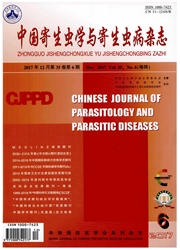

 中文摘要:
中文摘要:
目的动态观察弓形虫RH株速殖子(简称速殖子)体外入侵大鼠肠上皮细胞(IEC-6细胞)及其增殖过程。方法取24孔培养板,设实验组及对照组各3孔,每孔放置经预处理的盖玻片。将常规传代培养的IEC-6细胞接种于各培养孔,于37℃5%CO2培养箱培养24h,吸弃培养液,实验组每孔加入1ml速殖子悬液(含1×10^6个速殖子),对照组每孔加入1ml无抗生素培养液,共培养。用倒置显微镜连续观察速殖子粘附、入侵IEC-6细胞及其增殖过程,并分别于共培养5~30min、1~48h后取出盖玻片,经吉氏-瑞氏染色后光镜观察其入侵和增殖情况,计算入侵率。结果共培养5min,速殖子即可入侵IEC-6细胞,随着共培养时间的延长入侵的速殖子逐渐增多,1h为1~5个,入侵率为(55.0±6.6)%。2h入侵率高达(81.8±10.2)%,有假包囊形成,速殖子可入侵细胞核并在核内增殖。4h入侵率降为(80.8±9.2)%,假包囊破裂释出成簇排列的速殖子。6h入侵率为(75.1±8.2)%,成簇排列的速殖子显著增多。12h成簇排列的速殖子减少,多数速殖子游离细胞外,完整的IEC-6细胞明显减少。24h只见部分IEC-6细胞和假包囊存在,有大量游离的速殖子。48h见大量游离速殖子,未见贴壁细胞。结论体外培养的弓形虫速殖子可迅速入侵IEC-6细胞,并可在细胞质及细胞核内增殖。增殖周期为6~12h。
 英文摘要:
英文摘要:
Objective To study the invasion and proliferation in IEC-6 cells of Toxoplasma gondii RH strain tachyzoites in vitro. Methods T. gondii tachyzoites of RH strain were co-cultured with IEC-6 cells in vitro, the process of cell adhesion, invasion and proliferation by tachyzoites was observed consecutively with inverted microscope. At 5 min, 10 min, 20 min, 30 min, 1, 2, 4, 6, 12, 24 and 48 h after co-culture, the tachyzoite invasion to IEC-6 and intracellular proliferation were observed with Giemsa-Wright's staining, respectively. The invasive rate of tachyzoites to IEC-6 was counted. Results T. gondii tachyzoites invaded the IEC-6 cells 5 rain after culture, thenceforth the invasive rate increased gradually. The invasive rate was about 55.0% at the first hour after culture with 1-5 taehyzoites in one cell. In the second hour after culture, the rate reached highest with 81.8 % and there were many pseudocysts emerging. At the same time, tachyzoites invaded the cell nucleus and proliferated in the nucleus. At the 4th hour after culture, the invasive rate began to decrease (80.8±9.2)%, the pseudocysts began to break and tachyzoites were released to cluster. The clustering taehyzoites increased significantly at the 6th hour. At the 12th hour the clustering tachyzoites decreased and most tachyzoites were free, the number of complete cells decreased obviously. There were only a few cells and pseudocysts left at the 24th hour, and a great quantity of free tachyzoites existed out of the IEC-6 cells. There were plenty of mobile tachyzoites while none of IEC-6 ceils existed after 48 h culture. Conclusion IEC-6 cell may be the suitable target cell of Toxoplasma gondii tachyzoite. The tachyzoites can invade the IEC-6 cells quickly in vitro and proliferate in the plasma and nucleus with a reproductive cycle of about 6 to 12 hrs.
 同期刊论文项目
同期刊论文项目
 同项目期刊论文
同项目期刊论文
 期刊信息
期刊信息
